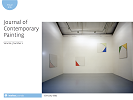- Home
- A-Z Publications
- Journal of Contemporary Painting
- Issue Home
Journal of Contemporary Painting - Current Issue
Helen Frankenthaler, Apr 2023
- Editorial
-
-
-
Editorial
More LessThis edition of the Journal of Contemporary Painting is dedicated to examining the work and legacy of the American artist Helen Frankenthaler (12 December 1928–27 December 2011). The issue contains new writing by artists and academics, with contributions from Suzanne Boorsch, Cora Chalaby, Melissa Gordon, Joan Key, Katie Pratt and Alison Rowley.
-
-
- Articles
-
-
-
Helen Frankenthaler: Something new in terms of nature
More LessOriginally presented as a talk at Turner Contemporary Margate in 2014 in association with the exhibition Making Painting: Helen Frankenthaler and JMW Turner, the article explores the importance of Helen Frankenthaler’s exposure to the work of Paul Cézanne in exhibitions in New York in the early 1950s for the making of her breakthrough painting Mountains and Sea in 1952 and speculates about her engagement with the work of Nicolas Poussin in her painting Eden (1956).
-
-
-
-
Frankenthaler, woodcuts and Japan
More LessHelen Frankenthaler was five days short of her thirteenth birthday when the Japanese bombed Pearl Harbor, on 7 December 1941, causing the United States finally to enter the Second World War. She was 16 in August 1945 when the United States dropped atomic bombs on Hiroshima and Nagasaki, putting an end to the war. Yet, despite the fact that Japan had been the Enemy, many Americans – including many American artists – became fascinated with Japan and its culture in the years following the war. This article details the particular importance of Japan in the creation of the works in the exhibition Helen Frankenthaler: Radical Beauty, at the Dulwich Picture Gallery, London, in 2021–22 – Frankenthaler’s extraordinary woodcuts.
-
-
-
Liquid gestures: The language of that land
More LessThe painterly language arising from the paintings of Helen Frankenthaler finds itself describing gestures that behave ‘in-between’ constructed histories. Historic accumulated gestures by female painters and artists at seminal moments in history point towards spaces in which contemporary artists can speak about how new painting language can be formed, now. Using notions of liquidity from Giorgio Agamben and Luce Irigaray to think of a new painterly terminology. The field of making, the performance and transitive material visualizations of Frankenthaler’s practice makes space for the voices of female painters after her.
-
-
-
The bureaucracy of freedom
More LessBy Katie PrattWhen Helen Frankenthaler said ‘no rules’, everything was up for grabs: she would interrogate, disrupt or disregard conventions. While Frankenthaler had the perception to envision what she intended to make, for some artists that deterministic state of knowing can be elusive. The author reflects on Frankenthaler’s maxim ‘no rules’ and compares it to their personal experience of painting practice. This article explores the impact of a single decision on the direction and outcome of an artwork and investigates the balance between regulation and artistic intuition in the author’s painting. The article further explores the concept of artistic freedom and the paradox it presents. It suggests that many artists introduce problems or limitations to navigate the creative process. The author outlines their own artistic methodology which utilizes rules, algorithms and systems to navigate artistic decision-making and to create a dialectic tension between structure and artistic freedom.
-
-
-
Cullinan Richards: A visit to the studio, 9 December 2022, Painting Fluid Thinking1
More LessBy Joan KeyThe long-term collaboration of Charlotte Cullinan and Jeanine Richards, originally predicated on painting, extends to its studio management; conceptions of work-sharing; design of formats of presentation and exhibition strategy. This raises a question of how far the conception of ‘a painting’ could hold in a context where paintings’ contiguity with boundaries and processes is already a debate arising from variables explored through shared production. The positioning of painting as ‘installation’ further destabilizes the discreet objecthood of a painting resolved within a solidifying frame. Taking up a conception of fluid materiality as a metaphor for this instability, reference is made to both painting and feminist philosophy: Helen Frankenthaler’s development of a painterly language of fluid applications and Luce Irigaray’s terminology of ‘fluidity’ as a physical and discursive interrelation, based in a double experience of feminine physiology. Frankenthaler’s fluid paint and Irigaray’s poetics of fluidity, devised to imagine a non-hierarchical discourse, are contemporaneous but may have no historic connection. The term ‘fluid’, drawn from both these sources, will be used to read an imaginative and purposeful resistance to idealizing the authority of formal explanations of painting present within Cullinan Richards’s practice.
-
-
-
‘Someplace else’? Helen Frankenthaler’s printerly paintings
More LessBy Cora ChalabyThis article examines the role of printmaking in Helen Frankenthaler’s practice. While Frankenthaler is primarily known for her monumental abstract paintings and invention of her ‘soak-stain’ technique, printmaking formed a vital part of her oeuvre over five-decades. Countering ingrained material hierarchies, I consider how the printerly manifests within Frankenthaler’s studio practice. In a January 1970 lecture at Yale University, Frankenthaler asserted that that there was ‘a lot more room for development’ within painting and the ‘best of it is going someplace’. Taking up Frankenthaler’s proposition, I argue that her painting developed in the ‘someplace else’ of printmaking. As such, this article moves beyond the narrow confines of a medium specific discourse. Printmaking offers an alternate vantage point – spatially and materially ‘someplace else’ – through which to reconceptualize where and how Frankenthaler extended painting as an aesthetic category, subject and site of artistic production. Focusing on Frankenthaler’s work of the 1960s and 1970s, this article offers an exploration of the parallel reinvention of painting, printmaking and, concomitantly, the studio and workshop during this period.
-
Most Read This Month Most Read RSS feed


